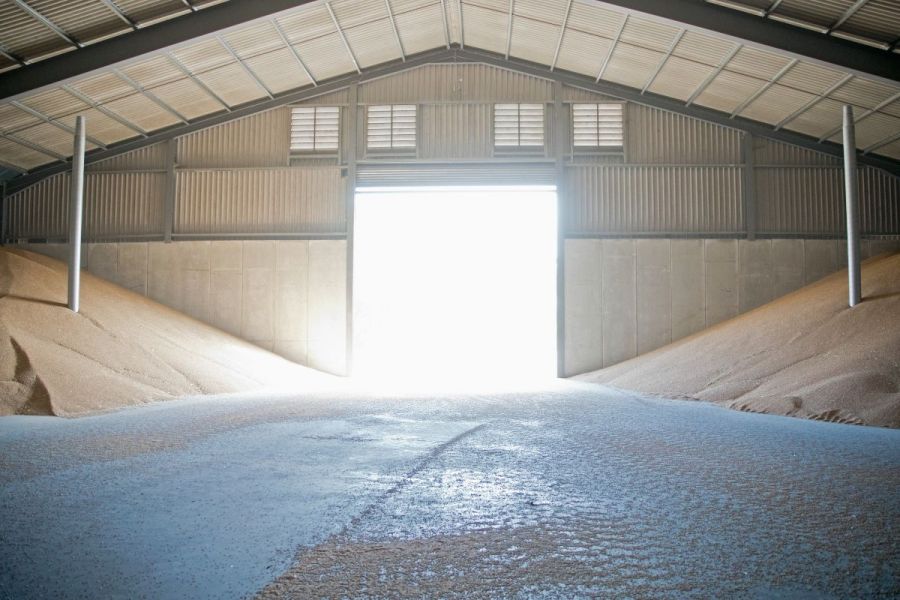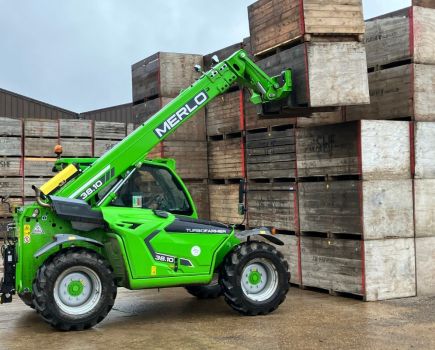Prioritising crop quality in the grain store can provide a multitude of benefits and doesn’t have to be an expensive investment. CPM speaks to a farm manager who’s installed a new system to reduce labour and put crop quality first.
“It’s a fairly regular occurrence that we see spoilage because there aren’t enough ducts or fans in sheds.”
By Melanie Jenkins
The crop has come off the combine and safely gone into the shed, where it might be for mere days or even months. But, irrespective of time, if the wrong factors come into play and sheds aren’t ventilated correctly numerous issues could arise, highlighting just how important cooling can be.
According to AHDB, later sold grain can often achieve a premium price compared with when it’s sold at harvest, meaning grain can often be stored for months at a time. But this opens the door for degrading quality which can then have a knock-on effect on the price crops can command.
If crops aren’t ventilated while being kept in grain stores they can be in danger of overheating, spoiling, rotting and getting bug infestations, says Rob Sweetlove of Evans and Pearce. “When your crop is valued at £150-£200/t you don’t want to be losing value from that, and when basic ventilation can be installed for £4-£5/t, it’s a no-brainer as it helps you to look after your crop.
“And this investment will last you 10-15 years or more. But in a lot of instances, I think money is allocated elsewhere as the investment is perceived as being less critical. However, it’s a fairly regular occurrence that we see spoilage because there aren’t enough ducts or fans in sheds to provide ventilation and this can often result in bug issues which is a false economy. Bugs won’t be active below 10oC and can’t survive in grain below 5oC – good ventilation can make all the difference.”
In a bid to prioritise ventilation, farm manager John Field has been instrumental in the installation of a Storecool system at Down Farm, F W Wallis and Son, near Rockbourn, Salisbury. The farm, consisting of 400ha owned and a 200ha tenancy, is all arable including winter wheat, winter and spring barley, oilseed rape, peas, oats and spring linseed.
Across the two farms there’s a mix of drying floors and freestanding grain sheds and so John decided to install Evans and Pearce’s Storecool system to help utilise the sheds and reduce the labour of crop handling.
“Usually, we’d bring the grain in to dry and then it’s put into the freestanding sheds which works but it’s time consuming and labour intensive. We’ve also had some crops come into the sheds which have had to be cooled and the work involved wasn’t worth it for the short time they were cooled for.”
A further labour-intensive aspect came in the form of a fairly modern four-year-old 1000t grain store at Down Farm. “The shed was open fronted, so by the end of October we could no longer store grain in it, meaning anything in store had to be moved. We’ve now fronted the shed, but despite being modern it has no gable end fans, so we usually just leave the doors open.”
In 2021 the decision was taken to purchase eight Storecool pedestals and six PV250 fans from Evans and Pearce. These are rotationally moulded pedestals which draw air from eight apertures at the base of the unit. According to Rob, drawing air from the base helps improve the effectiveness with which they service their working area.
To install the system into the 30x20m shed, which is split into two bays of 10x30m, the Storecool units were placed in the centre of each bay and electrical sockets were installed to allow them to run. The farm also has a further two flat concrete floored sheds, and due to the versatility of the system it can be moved among these depending on where it’s required, says John.
“We only bought six fans with the intention of rotating them on the pedestals, but I think we actually require one fan per pedestal so that we can cool the grain at the optimal time and aren’t left stuck unable to move onto the next area. If we had a big fixed drying system there’s less versatility, but with these the ability to change their position is a lot more flexible and versatile,” he says.
Pedestals come in both mini and standard options with the former suitable for depths under 2.7m and the latter designed for 2.8-5.7m depths. The plastic bases allow for easier maneuverability and are stackable for storage, and small seeds won’t enter the duct so they don’t require filters for use with OSR. They’ve also been designed to be lower to the ground making it easier to fill around them, explains Rob.
The fans have a cast aluminium case construction and hard-pressed steel impellers to help improve air movement. Each fan has a tapered 150mm inlet spigot to increase airflow to the impeller and an integral round 150mm discharge spigot as standard.
Rob advises installing one 1.1kW PV250 fan per 250t of grain which can be fitted with an optional temperature controller – Grain Fan Assist – which provides differential temperate control to supply air movement through the crop. “This monitors the temperature of the grain and the air so that when a set differential is met the fan will switch on. For example, it could be set so that if the grain is 18oC and the air falls below 14oC, the fan will switch on. Then when the differential is closed, the fan will switch off, meaning it’s only ever running when it’s drawing cool air through the grain.”
An on-screen display provides immediate and accurate temperature readings, something John has found beneficial. “With a manual probe you have to wait five minutes to get the actual temperature of the crop, so from a crop management point of view, we can have a quick whiz around the shed to look at the eight displays and get good readings at all these areas which speeds things up. However, we do still have to take moisture readings by spearing the grain and taking samples.”
It cost £8800 for the Storecool components and fans, and a further £600 for the installation of electrics and extension cables, says John. “It works out pretty cost-effective even though the system can be pretty thirsty on electric, especially when we’re running eight in one shed, but we’ve found we’re not having to run it a lot of the time. We try to bring the crop temperature down by working with the cooler nighttime temperatures and then we can switch the system off. And previously we’d found we would get capping on the grain at the front of the big grain shed but this doesn’t happen anymore.”
John has also found that by using the system, crop moisture can be brought down anywhere from 0.5-1% depending on the weather conditions. “How quickly we can bring the temperature of the crop down does depend on what the temperature of it is when it goes into the shed. It was a struggle to reduce the temperature of the crop in 2022 because the harvest was hot and so were the nights. Because the fans can both blow air into the crop and suck air out of it, we were sucking the air out during this harvest as it worked better for the conditions.”
Wheat was brought into the store at 26.6oC and 14.9% moisture, and after a month in the store this had been reduced to 18oC and 14.1%. “This was an unusually warm season,” says Rob. “The drying of the crop is unusual with a pedestal system, but this was down to the warm, dry conditions experienced during this harvest.”
Although it ended up being a longer more drawn-out process to lower the temperature, John says this was due to the conditions in 2022. “But in 2023, it was cooler at night so we were able to bring the temperature down a lot faster.”
Although John feels it’s hard to quantify the return on investment, he believes that the system has made a positive difference on the farm. “It’s meant there’s a bit more manual handling for the team member who’s doing the grain store management but overall it’s a positive as we’re not getting the capping of the grain in the main store. It also means we can use this store to bring temperatures down, and we used to have to make sure the crop moisture was right before bringing it in, but now we have that 1% leeway this is something we can address once the crop is in the shed.”
All crops go to Frontier, Openfield and Robin Appel and John says the system has a positive knock-on effect when selling grain. “The merchants send someone to take samples and visually it looks good to them, giving confidence that the bulk of the grain will be well managed and looked after.”
The next step is to install gable end fans into the large grain store, says John. “You can feel the humidity coming off the top of the grain when the fans are running so improving the airflow is paramount to getting the maximum out them. We’re also going to purchase another two fans so we can have all the pedestals operating at once,” he concludes.
This article was taken from the latest issue of CPM. For more articles like this, subscribe here.
Sign up for Crop Production Magazine’s FREE e-newsletter here.




